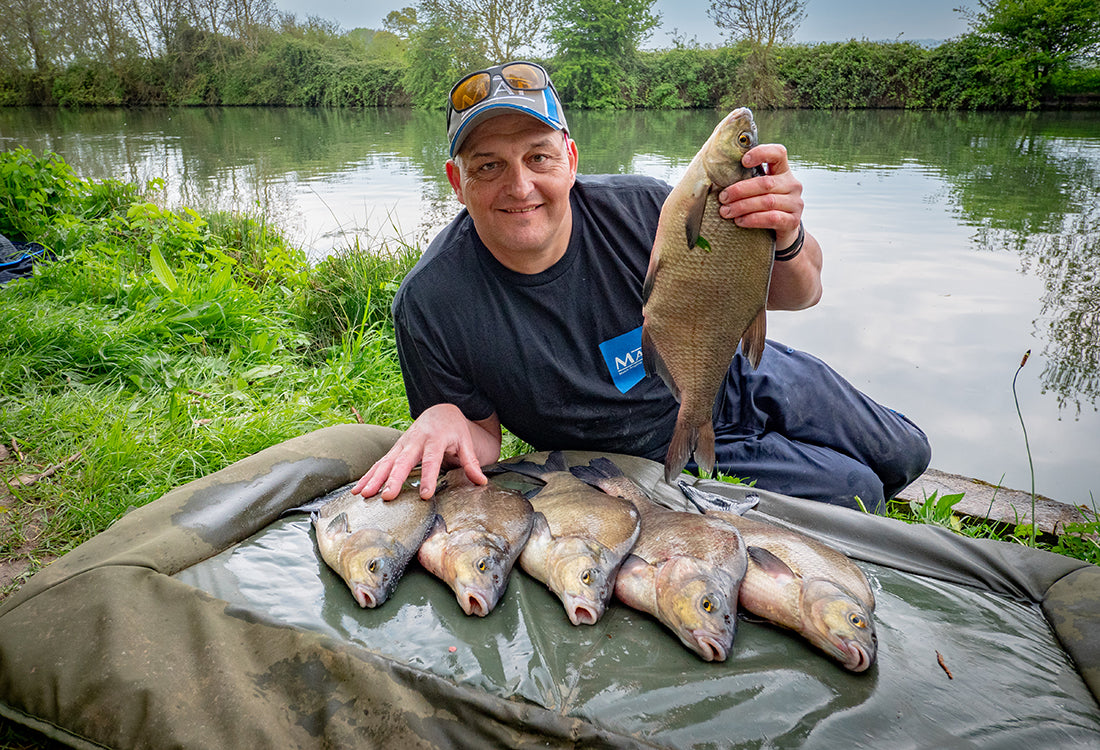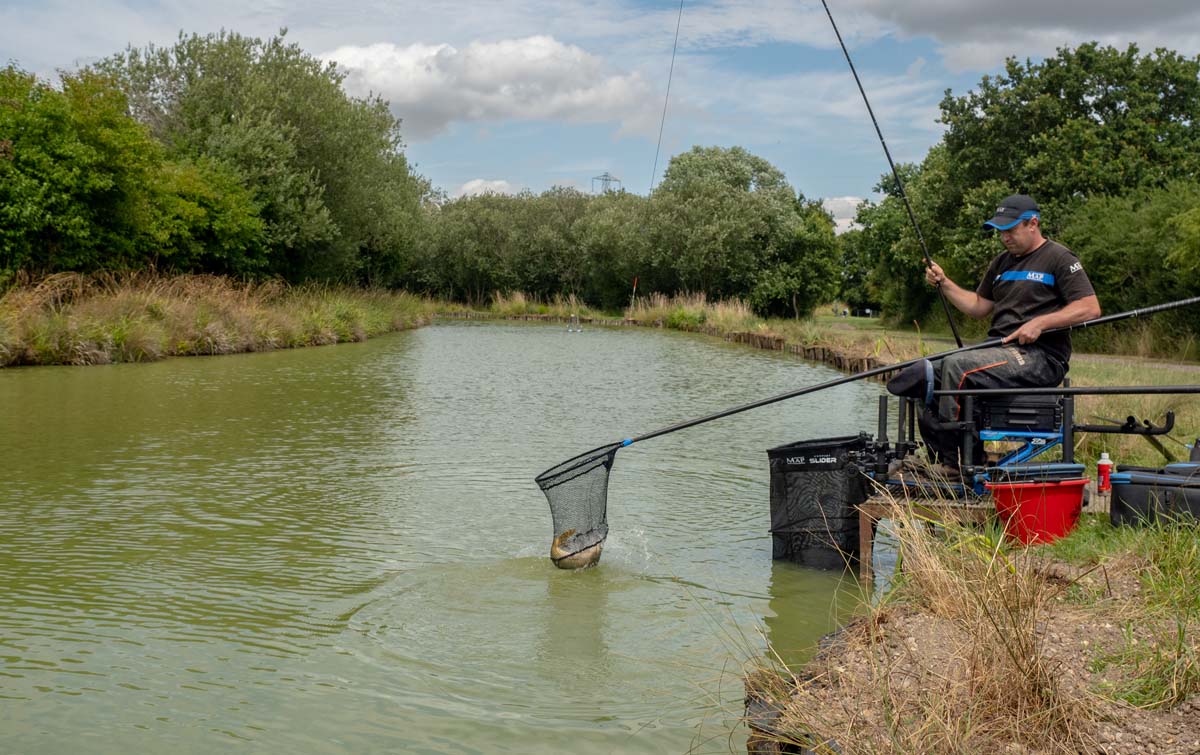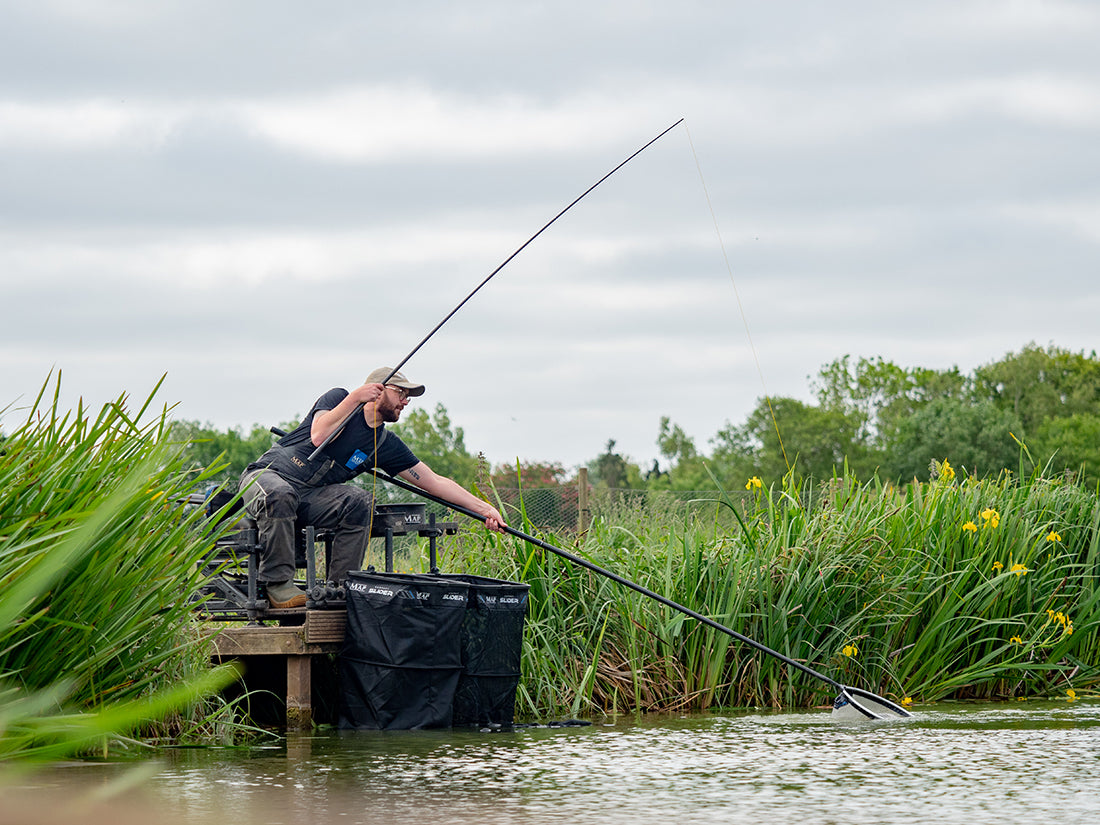The Winning Mentality!
Tackling big deep canals requires the right mindset to succeed – we join MAP backed Ian Didcote on the banks of the Gloucester Canal for an insight into his positive approach.
Tackling big deep canals requires the right mindset to succeed – we join MAP backed Ian Didcote on the banks of the Gloucester Canal for an insight into his positive approach.

The Gloucester Canal is a venue that is regularly featured in big matches hosting events including Feedermasters, the Feeder National and the Division One National. Big events like these require the right approach if you’re going to succeed either individually or as a team and going down the wrong route can lead to disaster!
With the canal being deep and wide, it’s a different prospect to most canal venues and most of the time targeting the right species is key to success.
It’s possible to catch numbers of small fish, but according to venue regular Ian Didcote, you need to set your sights higher by targeting the big shoals of bream and skimmers that are spread throughout the venue.

We caught up with Ian on the banks of the Gloucester to see how he goes about tackling this notoriously difficult venue on the feeder. Over the years, the canal has been a happy hunting ground for Ian, so it was the perfect opportunity to extract some of that experience and give an insight into what makes him so consistent on the venue.
The Winning Mentality
When you’re fishing on a venue like the Gloucester Canal you have to remember that it is completely different to other canals, you’re likely to find around the country.

First of all, it’s a deep canal which is usually around a top-five deep this means that the fish have a lot of water to swim around in and more often than not, they’re not actually living on the bottom.
The canal is also quite wide, the section we’ve come to today is narrower than some of the other stretches this means that you have a lot of choice when it comes to fishing the right distance across the canal too and it’s these things that can really make the difference.
Mindset is everything on the Gloucester Canal and the first thing that may surprise you is that 95% of the time I will not bring a pole with me, pinning my faith in a feeder approach.

My reasoning for this is that every section on this canal will require an amount of bream or skimmers to figure high up in your section or match to compete.
Catching 2lb of bits on the pole doesn’t get you very far at all and the chances are, if you fished the feeder, you’d catch that 2lb anyway but most importantly you’re giving yourself the best chance of catching some quality fish too.
You have to keep the faith that at some point, you’re going to get a chance and on this canal it’s possible to carve a result on most occasions! I would describe my approach at ‘negatively positive’ as you may be surprised that I actually feed next to nothing throughout five hours!

Instead, I set a trap for one fish at a time, which also makes my approach failsafe, whether I’m on a lot of fish, or I’m on a harder section – I cannot ruin my peg, and most importantly when a fish is in my peg, I’m more likely to get a bite from it with less bait available to them on the bottom.
On The Right Line
Fishing the right areas of your peg on the canal is an important consideration – generally, I fish two lines on the majority of pegs I draw. The first is a short line at 8-10 metres the other is fished around three-quarters of the way across, the longer line being where I’ll be spending the majority of my time.

The short line can be an excellent resting line and somewhere to switch to later in the match, again this line is frugally fed but I liken it to a short line on a commercial, sometimes it won’t produce but it can also give you a great run of bites to finish the match.
Another time I utilise the short line is if we have one of the huge boats go through the longer line, I can drop in on this line for ten minutes and give myself a chance of a bite while the sediment settles down on the long line.
The Set Up

My set up for both lines is exactly the same, a soft 11ft MAP Parabolix Pro Feeder rod fitted with the lightest tip, a compact 3500x Parabolix reel loaded with 0.10mm braid – this is fished direct as there is no advantages to shock leaders when I’m only casting short distances.

The rig is a standard running feeder on a snap link, with a glass bead and a short five-inch piece of 8lb mono tied to the braid which I attach my hook length to via a loop-to-loop connection.

The hook length is 50cm of 0.15mm Optimum Power down to a size 16 red LS-2210r hook which I find brilliant for this style of fishing.
Feeder wise, I only use two different feeders here on the Gloucester Canal – small cages and window feeders.

Cage feeders are excellent for getting a few fish in the peg as they always leave a little trail of groundbait through the water column, but once the fish arrive or I’m getting lots of liners but struggling for bites, a switch to the window gets them following the feeder down to the bottom and speeds up the bite time.
Bait
The side tray is kept extremely simple; I’ve got a huge side tray but there is next to nothing on it! Today, I’ve bought with me a maximum of a pint of dead maggots and pinkies, some dendras for chopping and some red worms for the hook and that’s it.

The main base of my feeding is done with groundbait – I like to use fishmeal mixes due to the amount of bigger bream and skimmers in the venue and a mix of Dynamite Baits Amino Black Swim Stim, F1 Sweet and Silver Fish Dark gives me the perfect blend of fishmeal and sweeter flavours which ensures the smaller skimmers aren’t put off by a super strong fishmeal.
The other main bait for feeding is worms – I don’t just chop these into pieces, I use a blender to quite literally create a worm soup.
I don’t always feel fishing worms on the hook is great and you often get more bites on maggots but there’s no doubting that they’re attracted to the smell of minced worms and is the only bait I put through the feeder for the majority of the day, it offers me a huge amount of attraction, but again doesn’t leave much on the bottom for the fish to feed on meaning getting a bite is more likely.

A big mistake I see a lot of anglers making on this venue is that they feed far too much at the start of their match, I feed just four bait-up feeders of groundbait on my longer line, and just two on my shorter line which includes a small amount of minced up worms.
The Session
To demonstrate the tactics that have served me so well on this venue I’ve come to the Slimbridge section today. After quickly tackling up and sorting out some bait, I’ve fed my initial four feeders on the long line, and two short.

The starting hook bait for me is always a single dead red maggot, this can often trip up a couple of quick fish for you before the swim has really settled down and a great way of maybe putting an early bonus bream in your net.
After all, a 20lb weight is excellent in any section on the Gloucester so one or two decent fish early gives you a huge amount of time to hit that target.
Starting on a cage I didn’t have to wait long for my first bite as after two minutes the tip pulled round and dropped back – I was in, and a decent bream of around 3lb was soon in my keepnet. I had another quick fish, before I started to get linered to death!

Liners when you’re fishing a cage feeder usually means that the fish are sitting off the bottom, and they need to be dragged down. Once this happens it’s the signal to change to the window feeder – only reverting back if I feel I need to draw some fish back into the area.

Changing to a 20g window and fishing a redworm with a dead maggot on the hook I had an almost instant bite, in fact when I landed the fish there was still some bait in the feeder which just goes to prove the fish follow the feeder straight down and without lots of loose maggots and pinkies on the bottom, my hook bait is singled out immediately.

Over the next couple of hours, I caught fish regularly including the ‘bread and butter’ skimmers which can be found throughout the canal along with a number of proper bream.
The main point to emphasise about my approach is that no matter what peg you’ve drawn or what section you’re in, you’re never in danger of ruining your peg and when that window of opportunity opens, you’re going to get the bites and make the most of it as you haven’t over done it with bait!

During the summer months when it’s really hot, the periods where it’s possible to get a bite from a bream or two can be just a ten-minute duration in five hours and when there is a lot of bait in your peg, you’re unlikely to capitalise.
After catching a few fish on the long line initially, it wasn’t long before a huge Gloucester Canal dredger was coming through the peg.
This gave me a good opportunity to show how to restart the long line – in a match situation this would mean dropping onto the short line for ten minutes, it’s amazing how many times when one of these boats goes through you can have a couple of quick bites closer in.

Once the water and sediment has settled on the bottom out long, I like to feed a single bait up feeder to kick it off again and then go back out on it, the bait gets dispersed a bit by these huge boats but the fish know where your fed area is so there is no need to feed like you’re starting the match over again.

With a small skimmer on the short line, it was back onto the long line – today, dead red maggot seemed to be the best bait but you always need to experiment with this on the day and by swapping between red maggot and redworms I managed to keep bites coming.
After the disturbance of the boat, I had another great run of bites catching some of the Gloucester’s bigger residents and at the end of our short four-hour session I’d put together 45lb of bream and skimmers – I’d still got half of my 2-pint tub of groundbait left and used thirty maggots along with a few worms!

It just goes to prove that having the right mindset, confidence in what you’re doing and ensuring that you’re always giving yourself the best possible chance of catching the fish you need to do well in these big matches, whether you’ve drawn well or not, is so important.




